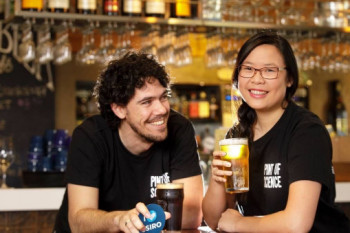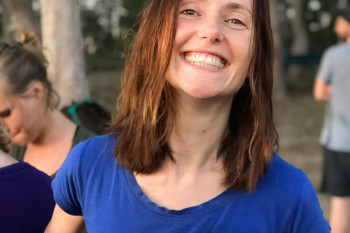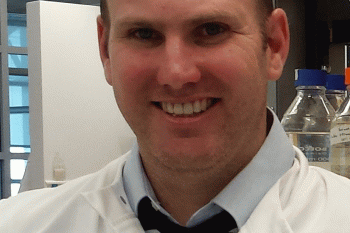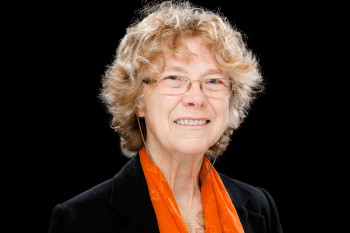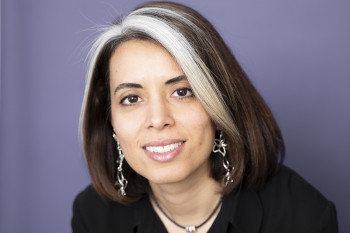© Pint of Science, 2025. All rights reserved.
Foot Appreciation
Professor Viv Chuter with Dr Nattai Borges
Let's take a moment to talk about feet! How do we support what supports us?
Professor Viv Chuter is a podiatrist who is passionate about helping people and keeping them healthy. Join us as we chat about the range of skills podiatrists have and how they use these skills to help people with chronic conditions.
Viv also provides some insights into how important foot care is for people with diabetes and the specific health care needs of Aboriginal and Torre Strait Islander Peoples in this episode shot at the picturesque Ourimbah campus of the University of Newcastle.
~~
Prof. Viv Chuter is the Head of the podiatry Discipline and has been focused on developing and establishing the undergraduate Bachelor of Podiatry. Prof. Chuter's research focusses on diagnosis and treatment of musculoskeletal and vascular pathology of the lower extremity.
~~
Transcript
Professor Viv Chuter: It's across the board we are a very multicultural society in Australia and health practitioners need to be able to adapt the way we deliver healthcare across the board
Dr Nattai Borges: Hi everyone and welcome to Mug of Science a Pint of Science initiative here for 2021 my name is Nattai and today we are filming from the lovely Ourimbah campus, particularly at the yarning circle at the Ourimbah campus of the University of Newcastle and I'm lucky enough to be joined by Professor Viv Chuter. Viv is the head of program for the podiatry program and today we're going to be talking about all things science and podiatry, so Viv welcome thanks for joining us.
Viv: Thanks for having me Nattai
Nattai: We start every interview with the same question, we're running an informal survey about what scientists tend to drink either for their morning or afternoon beverage, so the first question as always is what is in your mug?
Viv: Generally coffee
Nattai: Generally coffee?
Viv: Generally coffee unless it's after 6 pm, and then who knows
Nattai: Who knows then it is party time! Great, all right Viv why don't you tell us a little bit about yourself, who you are as a person what brought you to science and what led you on the path that you're on.
Viv: Well I'm a podiatrist for those of you who are unaware podiatrists generally treat feet and injuries of the feet and legs I started as a podiatrist quite a while ago now and I started working in clinical practice and what I found when I was working clinical practice was that I had a lot of questions that we didn't really have good answers to particularly about the best ways to treat people the best ways to assess certain injuries and how we can get the best outcomes for our patients and that's what really got me into science and got me into doing research and that's what made me decide that I wanted to take on a career in teaching people about podiatry and also furthering our knowledge of podiatry in terms of medicine and how we can improve outcomes for our patients in the future.
Nattai: Yeah I feel like the foot is often an overlooked part of the body, it's a bit of a workhorse and I don't think it gets the attention or the respect that it deserves. Was there anything that, did you have an ankle injury or a foot injury when you were young or is it something you just fell into?
Viv: Yeah that's a really good question it's very much something I fell into but when I was choosing a career that I wanted I originally thought I wanted to be a health practitioner purely as opposed to being a clinician and a researcher but I think I originally wanted to be a health practitioner because I wanted to help people and also I decided to be a podiatrist because I discovered podiatry from my neighbour who was a podiatrist at the time and she told me about the I guess the big variety of things that she saw in her practice and it got me interested in thinking about the different ways that we can contribute and the different populations that we deal with so as podiatrists we will treat children we will treat very elderly people we will treat really chronically ill people we can treat sports people so it really depends on what you're interested in and what area you want to go into so the scope of what I could do was what attracted me to being a podiatrist specifically
Nattai: Yeah that's really interesting I'm just wondering if you could maybe before we get into the research side of things just tell us a little bit more about the scope of practice for a podiatrist because I've heard they're almost like a mix between a nurse and a GP and an allied health professional and a physio all kind of mixed into one and you know the things you have to do day to day are actually quite broad and quite individual I guess
Viv: Yeah and that's very true I think it's probably not widely known that we can deal with highly clinical medical problems so we deal a lot with people with diabetes with foot ulcers we're really involved in preventing amputations in really ill people but then on the flip side of that we also deal with children's injuries and growing pains and then in the middle of that we have people who might have occupational injuries we have sports people so we just have this scope of practice that encompasses musculoskeletal and medical problems and so yeah we reflect a lot of different professions all rolled into one and we have great opportunities now as podiatrists that we can specialise in the diff in the areas that really interest us yeah which is wonderful
Nattai: yeah so it's not just insoles?
Viv: No not just insoles not just toenails they're only a tiny fraction of what we do
Nattai: Great so are there any projects that you're running at the moment that you know you want to discuss in a bit more detail like you spoke about foot ulcers and yeah is there anything
Viv: So I run some research around diabetes related foot disease, so foot disease and diabetes is probably also not very well recognized in the general community but people with diabetes are really at risk of developing severe conditions in their feet that can actually result in them losing limbs and can mean that they die a lot earlier than they should and so a lot of our research is around determining better ways to assess people to identify the people who are at risk of developing these foot complications and also better ways of actually preventing people in the community developing the foot complications we have so many people in the community now who are living with diabetes who are having to manage it on on a day-to-day basis and what our research is trying to do is give them things that they can easily implement themselves so things like simple exercise that can actually help reduce their risk of developing complications that could end up in them developing a foot ulcer that leads to an amputation I think one of the things that's been hard for podiatrists previously is knowing the best way to actually assess these people coming into our clinic so what test is the best test to decide if the foot the blood flow to the foot is enough what test is the best test to figure out if they can feel enough to protect their feet because people with diabetes can have problems with their circulation they can have problems with their sensation in their feet and so it means they can step on things and not feel them so it's not uncommon when you're working in a clinic and dealing with these people that they will come in and they've stepped on a drawing pin and still in their foot when you see them in the chair and they have no idea it's there so identifying better tests make us better at our job and so we can you know group of people so we could have a whole lot of people sitting in a room with diabetes and from these tests we can pick the ones that we need to really worry about and it's like okay this group of people over here at really high risk of developing these complications we need to look after you especially well you need to come and see us more frequently because we need to do a lot of different things to try and stop any of these things progressing to the point where you're at risk of losing your limb
Nattai: Yeah and I guess it's all interlinked like again and just showing the role that podiatrists can play in in an allied healthcare profession I mean I think of diabetes and I think of lifestyle interventions such as you know nutritional interventions or exercise but if they develop you know issues with their feet because of poor circulation and then they can't exercise you know that's an aspect or a perspective that I hadn't really thought of before and is really important
Viv: Yeah so it can make it really challenging for people with diabetes who have full complications to actually perform those activities that can help them stay healthy so part of our research is actually trying to figure out which are the safest ways for them to be able to exercise for example safely because we know that extra exercise has a whole lot of health benefits but it also can help with things like potentially help with things like wound healing and so we want to be able to keep these people active despite the fact that they might have foot disease to try and prevent anything getting worse and to try and help them stop all the other complications that occur as a result of diabetes a lot of our research we're doing now is also in Aboriginal and Torres Strait Islander peoples because they have far less outcomes from diabetes than the general population and what we're looking at in that population is ways that we can actually support them to achieving better health outcomes in systems of healthcare that actually suit them a whole lot better than our general models that we use for everyone
Nattai: Yeah it's really interesting so you mentioned a couple of assessment techniques and you know different forms of exercise and maybe some specialised care for Aboriginal and Torres Strait Islander peoples can you elaborate a little bit like what kind of assessment tools have you found to be effective and is there a specific form of exercise
Viv: So what we've found is that some of the ways that we assess whether or not people have got disease in the arteries going to their legs are better at picking it up than others so probably one of the ways we have typically assessed in the past is by taking pressures at the ankle and the blood pressure and what we've found from the research is that that doesn't always pick it up in people with diabetes because they have other changes that happen as a result of diabetes that affect those ankle blood those ankle vessels that stop us taking accurate measurements and we've found that measuring at the toe for example is probably going to be better able to detect whether or not they've got any kind of disease we've also found that um people who have uh neuropathy have worse skin blood flow so when we measure skin blood flow we use something called a laser doppler and that actually picks up the blood flow and the very tiny capillaries in your skin so while the large arteries can seem okay when we get down to these tiny tiny little vessels sometimes they are not as healthy as they could be and when they lose their sensation and their nerve supply they don't work as well as they could now this doesn't seem like a big problem generally but once you develop something like an ulcer we actually really rely on those tiny tiny blood vessels to be able to open up and to be able to get more blood there and more white blood cells and be able to kill off any infection and actually encourage that wound healing and if we've got neuropathy it's potentially that that's not the case that's not happening as it should so what i'm looking at is whether or not something like exercise so doing simple exercise like could be bike riding stationary bike riding it could be walking whether that can actually encourage those blood vessels to behave more normally and so when they when there is injury to the skin they open up they get the blood flow there and they actually promote that healing response because if we get good healing then we're not going to end up with those outcomes like where we're losing limbs and losing toes.
Nattai: Yeah it's all about blood flow
Viv: It is all about blood flow
Nattai: So you mentioned kind of cycling as a potential form of exercise that you know might be good at mediating or improving that blood flow without maybe exacerbating kind of symptoms of the foot are there any other kind of interventions that you're working on at the moment
Viv: Well there's a couple of different ways because we can actually try and prevent complications with exercise some of them relate to exercise where we're doing cardiovascular exercise so exercising our heart and lungs some of it relates to being able to stretch our muscles out because one of the things that happens when we have diabetes is our tendons and our joints get really stiff so we have all these extra glucose running around our blood so the sugar in the blood that we that we kind of we can't get rid of and it upsets the fibres that are in the tension in the skins or the collagen fibres and it changes the way they sit next to each other so they link together a bit differently and it makes those structures really stiff yeah and so that stiffness actually then affects the way we walk so it makes our toes claw up and so then we get high pressure areas under our toes it makes us load up our forefoot so under the ball of our foot because our Achilles tendon the big thick tendon at the back on our heel gets really stiff and that actually increases the risk of developing um a pressure wound under that part of our foot and that's when we can go on and develop things like an amputation so what we look at is ways that we can actually try and alleviate that process so stretching a muscle so a simple calf stretch we've been looking at to try and increase our range of motion at ankle joint to get a more normal walking gait and also to try and reduce some of that forefoot pressure so it's about trying to I guess using exercise in all its different forms yeah to try and target some of those complications that we're getting and also get the general health benefits because exercise is medicine
Nattai: Yeah I always say that you know every form of exercise imparts its own specific type of stress and the body will adapt to that in a specific way so using multiple different forms of exercise is generally the way to go. Great so, I guess you also mentioned specific needs of Aboriginal and Torres Strait Islander peoples in this area would you like to elaborate on that a little bit as well
Viv: Absolutely yeah so in terms of diabetes for Aboriginal and Torres Strait Islander peoples um the outcomes are a lot worse than for the general population they tend to have more foot problems and it tends to affect them systemically so they get worse complications so it might be in their heart nerves kidneys so they have a lot worse outcomes for their entire body and therefore a lot worse health outcomes so and what we find is the way that they access healthcare is a little bit different to I guess a western model of healthcare so we set up all our hospitals and everything because we think well that's the way we like to go we like to turn up to appointment at a particular time and um we're used to this model but this model is not suitable for everyone so different cultures have different needs and different expectations and it doesn't necessarily the way we deliver healthcare doesn't necessarily meet the requirements of Aboriginal and Torres Strait Islander peoples need for podiatry and in particular in relation to foot health we've got a few different clinics around the country that have been set up specifically for Aboriginal People so we actually asked them what do you want and help you and your feet feel better and that is a really effective way of actually getting them what they need so a lot of our research is about finding out how we can best support Aboriginal and Torres Strait Islander peoples to get better health outcomes so the specific things they need in the way that we deliver health care the service types that we need the people that they want in there and what they are worried about and what we can do to help them overcome the things that are a problem to them and I think for us in podiatry this is a really evolving process because we've only just started this journey and it's about learning how to deliver culturally safe care where people feel safe coming to get care from you they know that they that you understand what they want and that you're willing to listen to what they want and that is part of something that we will be going through for many many years to come because becoming culturally capable as a health practitioner is a really important thing for any health practitioner in Australia in any country but for us in Australia to try and help Aboriginal and Torres Strait Islander peoples have the same healthcare outcomes as the rest of us to live as long as the rest of us it's really important that we take a good hard look at ourselves and the way we deliver health care and actually start to listen to what they need and what they want and how we can better deliver health care for them
Nattai: Yeah it's definitely not a one-size-fits-all type of situation it really isn't we need to tailor our interventions for specific populations
Viv: Absolutely and you know it it's across the board we are a very multicultural society in Australia and health practitioners need to be able to adapt the way we deliver health care across the board
Nattai: Yeah very true very true all right Viv so um thanks so much for your time today we like to finish all of our interviews with the same question which is complete the sentence for me for you a scientist is someone who..
Viv: Asks hard questions and goes and finds the answers
Nattai: Yeah and does the things that no one else wants to do
Viv: The hard questions
Nattai: Yeah great all right Viv thanks so much for your time today, thanks everyone for tuning in to this episode of Mug of Science I hope you enjoyed it please keep checking the website for daily episodes and we'll see you in the next one
